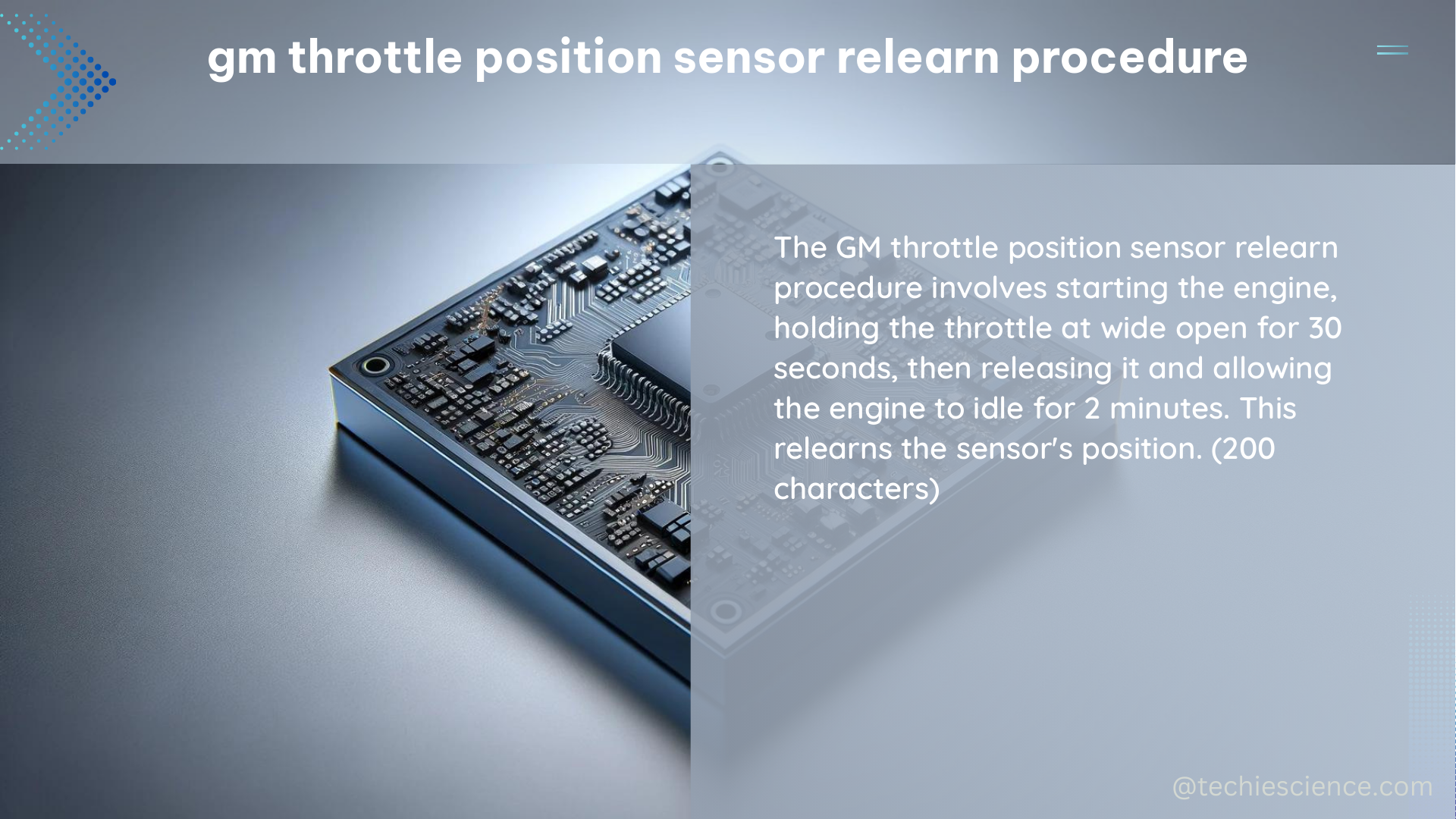The throttle position sensor (TPS) is a critical component in GM vehicles, responsible for controlling the engine’s idle speed and throttle response. Over time, the powertrain control module (PCM) makes incremental adjustments to the TPS, compensating for factors like carbon buildup in the throttle body. When a new or cleaned TPS is installed, the PCM still operates as if the original unit is in place, leading to poor or erratic idle. To address this issue, a thorough TPS relearn procedure is necessary.
Understanding the Importance of TPS Relearn
The TPS is a potentiometer that measures the position of the throttle blade, providing the PCM with real-time data on the throttle position. This information is essential for the PCM to accurately control the engine’s idle speed and throttle response. When the TPS is replaced or the throttle body is cleaned, the PCM needs to relearn the new throttle position to maintain optimal engine performance.
Without a proper TPS relearn, the PCM will continue to operate based on the previous TPS data, resulting in issues such as:
- Rough or unstable idle
- Delayed throttle response
- Difficulty maintaining a consistent engine speed
- Potential triggering of check engine lights and diagnostic trouble codes
Performing the TPS relearn procedure is crucial to ensure the PCM can properly adapt to the new TPS and provide the desired engine behavior.
Step-by-Step GM TPS Relearn Procedure

To perform the GM TPS relearn procedure, follow these steps carefully:
- Start and Idle the Engine in Park for 3 Minutes:
- During this initial idle period, the engine may run at a higher-than-normal speed.
-
This step allows the PCM to begin the relearn process and make initial adjustments to the TPS.
-
Turn the Engine Off and Wait 60 Seconds:
- This step gives the PCM time to reset and prepare for the relearn process.
-
It’s important to wait the full 60 seconds before proceeding to the next step.
-
Start the Engine Again and Let It Idle in Park for 3 Minutes:
- During this second idle period, you may see the check engine light illuminate.
-
Scan the vehicle for any throttle body-related diagnostic trouble codes and clear them if present.
-
Drive the Vehicle at Speeds Above 44 mph and Perform Acceleration/Deceleration Cycles:
- This step helps the PCM learn the new throttle position under various driving conditions.
-
Perform several acceleration and deceleration cycles to ensure the PCM fully adapts to the new TPS.
-
Repeat Step 3 One Last Time:
- This final idle period ensures the PCM has completely learned the new throttle position.
- The engine should now be running at a stable, consistent idle speed.
For vehicles equipped with HP Tuners or a Tech 2 scanner, there is an additional option to reset all idle data to zero. This forces the PCM to learn the new TPS more quickly, as it has no previous data to reference.
Verifying the TPS Relearn Process
After completing the TPS relearn procedure, it’s essential to verify that the process was successful. Here are some steps to confirm the relearn was effective:
-
Check for Diagnostic Trouble Codes: Use a diagnostic tool to scan the vehicle for any remaining throttle body-related codes. If no codes are present, the relearn was likely successful.
-
Observe Idle Speed and Stability: The engine should now be running at a consistent, stable idle speed. Any fluctuations or instability may indicate the relearn was not fully completed.
-
Test Throttle Response: Perform several acceleration and deceleration tests to ensure the throttle response is smooth and immediate. Any delays or hesitation may suggest the relearn was not successful.
-
Monitor Long-Term Performance: Continue to observe the vehicle’s performance over the next several drives. If the idle and throttle response remain consistent, the TPS relearn was effective.
If you encounter any issues or the vehicle’s performance does not improve after the relearn procedure, it’s recommended to consult a professional technician for further diagnosis and troubleshooting.
Conclusion
The GM throttle position sensor relearn procedure is a critical step in maintaining optimal engine performance after replacing or cleaning the TPS. By following the detailed steps outlined in this guide, you can ensure the PCM properly adapts to the new TPS, providing a stable idle, responsive throttle, and preventing any related diagnostic trouble codes.
Remember to always verify the success of the relearn process and monitor the vehicle’s long-term performance to ensure the procedure was effective. With this comprehensive understanding of the GM TPS relearn procedure, you can confidently tackle this important maintenance task and keep your GM vehicle running at its best.
References:
- Throttle Body Relearn Procedure: Must Do When Cleaning or Porting Throttle Body
- Throttle Re-Learn Proceedure
- Throttle Body Relearn Process
- New Throttle Body Relearn Process
- Throttle Position Sensor Relearn Procedure

The lambdageeks.com Core SME Team is a group of experienced subject matter experts from diverse scientific and technical fields including Physics, Chemistry, Technology,Electronics & Electrical Engineering, Automotive, Mechanical Engineering. Our team collaborates to create high-quality, well-researched articles on a wide range of science and technology topics for the lambdageeks.com website.
All Our Senior SME are having more than 7 Years of experience in the respective fields . They are either Working Industry Professionals or assocaited With different Universities. Refer Our Authors Page to get to know About our Core SMEs.